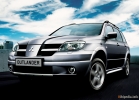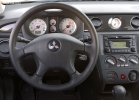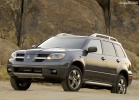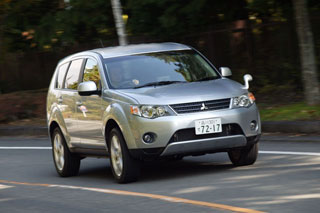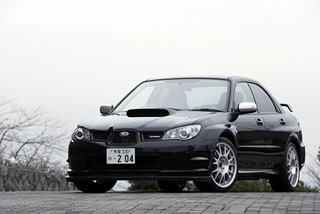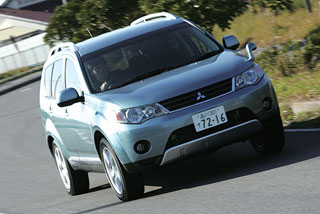Test drive Mitsubishi Outlander (Airtrek) 2003 - 2007 SUV
Newbie-Lesovik
 A trip to Spain in mid -April promised the sun and warmth. The reality turned out to be radically different rains, and in Moscow at that time it was under 20. However, I went there not for good weather, the occasion was more good. The wording is as follows: Mitsubishi built its Forester.
A trip to Spain in mid -April promised the sun and warmth. The reality turned out to be radically different rains, and in Moscow at that time it was under 20. However, I went there not for good weather, the occasion was more good. The wording is as follows: Mitsubishi built its Forester. Having serious experience in building all -wheel drives starting with the legendary Pajick and ending with the Space family, Mitsubishi, the last of the Japanese automobile companies, created its own SUV (PININ does not count).
In 2001, the SUV ASX concept was shown in Geneva. But everything began in America, but there, in a design studio, a conceptually new model for Mitsubishi was born.
The ASX shown in fact was a pre -production machine a year later it began to be sold in America and Japan. And after almost another six months, Outlander appeared and in Europe his prime minister took place in the spring in Geneva.
Outlander Japanese themselves position as something between the SUV1 class (Toyota Rav4, Honda CR-V, Nissan X-Trail) and Subaru Forester, Alfa Romeo 156 Sportwagon, Volvo V40). In my opinion, Outlander unconditional classmate Forester. This is not a full -fledged SUV and not even a SUV, and at the same time not a raised all -wheel drive version of the station wagon (Audi Allroad, Subaru Legacy Outback, Volvo XC70).
Outlander is clever than Forester, and seems more dynamic. And yet, as usual, the concept is much more interesting and alive than the subsequent serial model. ASX is more muscular, angrier, bolder. Outlander softer, more compromise is trying to please everyone. Although, of course, general proportions and motives are preserved. And individuality is achieved due to optics, chrome mirrors and handles of opening doors, predatory beak, large air intakes. Nevertheless, I did not attract much attention until I went to Outlander in Spain. He does not scream, as at one time Lexus RX300 or recently Nissan Murano. Yes, and why is there far the same Pajero of the last generation is much more advantageous in terms of design. The picture would be a little corrected by the wheels of inches that one instead of the standard 16.
 The interior is almost passenger, no off -road signs of additional levers, lock buttons, etc. Ordinary station wagon. The landing is deep, although, of course, the chair is adjusted in height. The plastic is generally interesting. Separate visors above the instruments, ventilation deflectors like on alpha, and the oval insert in the instrument panel recalls the jaguars, again the hourly in the center. The choice of materials and colors in the Mitsubisevsky shift Salon is black, with gray inserts. But the quality of both materials, and assemblies are on top. Like ergonomics. The seats are moderately tough, with developed lateral support. All governing bodies in logical places. The devices are large and informative, there is also a small window of the on -board computer. The steering wheel is regulated only in height, which, however, is quite enough.
The interior is almost passenger, no off -road signs of additional levers, lock buttons, etc. Ordinary station wagon. The landing is deep, although, of course, the chair is adjusted in height. The plastic is generally interesting. Separate visors above the instruments, ventilation deflectors like on alpha, and the oval insert in the instrument panel recalls the jaguars, again the hourly in the center. The choice of materials and colors in the Mitsubisevsky shift Salon is black, with gray inserts. But the quality of both materials, and assemblies are on top. Like ergonomics. The seats are moderately tough, with developed lateral support. All governing bodies in logical places. The devices are large and informative, there is also a small window of the on -board computer. The steering wheel is regulated only in height, which, however, is quite enough. The interior is spacious. In the second row, even with the front seats completely moved back, there are plenty of place for the legs. This also applies to the central passenger the floor tunnel is low, despite all -wheel drive. Both in width and in height of the place, too, with a margin.
The trunk is not a nonsense, a full -size reserve gets from the inside. The volume is almost the same as Forester 402 liters and 1049 liters with folded seats. There are not very many pockets and drawers, and those that are, small. But the back of the rear sofa is adjusted along the angle of inclination. And if it is folded with the front seat, you get a sleeping (or cargo) place 2400 mm long when laying out the rear seats, you do not need to throw the pillow, the back lies on top of it.
We, Russian journalists, were given all -wheel drive modifications for the test, because the front -wheel drive will not be supplied to our country. All cars with two-liter 136-horsepower gasoline engines and mechanical boxes. All silver, in the Sport configuration, as evidenced by cast wheels, tinted glass and roof religions. Full -wheel drive is constant, with equal moments on the axes and with an electronic differential lock, which redistributes the torque between the axes within 10%, depending on the slip.
At idle speed, the engine is not visible or heard. The speed set is frisky, with a capture after 4000 rpm. Until the limiter is triggered in the region of 7000 rpm. Switching is clear and unambiguous. The first gear is untwisted to 80 km/h, the second to almost 120, and the third to 150. On the fifth you can be painlessly accelerated from 50 km/h. The maximum speed was 180 km/h with a small one. The car confidently kept the straight line, and in terms of comfort in motion was close to the usual station wagon. Great sailing reminded of itself only with a strong impetusist wind.
The first test route was entirely highway. We walked under a downhill, at speeds close to the maximum, but we did not feel fatigue in the evening. As an asphalt car Outlander is very, very good. The sound of the engine does not announce at maximum speeds, the noise from the road is soloed. Aerodynamics are quite worthy of CC \u003d 0.43, only in the mirrors the wind whistles. Even when braking in the floor with 140-150 km/h on the wet coating of Outlander does not deviate from the straight line, for which thanks to the brakes with 16-inch discs and ABS C EBD (Electronic Brake-Force Distribution).
 The second day prepared us two off -road sections. It was planned that it would be a dirt road. But to the delight of all those present, the rains turned her into a fragmented country. So, even on Outlander's highway, it was confident in confident. A few lacked the torque on the bottom, so I had to move from about 2000 rpm, with a slight hint of slipping. The car overcame small fords and steep rises without much difficulty. However, we did not set the goal of planting the car.
The second day prepared us two off -road sections. It was planned that it would be a dirt road. But to the delight of all those present, the rains turned her into a fragmented country. So, even on Outlander's highway, it was confident in confident. A few lacked the torque on the bottom, so I had to move from about 2000 rpm, with a slight hint of slipping. The car overcame small fords and steep rises without much difficulty. However, we did not set the goal of planting the car. And a constant all-wheel drive is still good. On wet and slippery, like ice, Outlander clay allowed to move without problems under 60 km/h. And on a dry soil and, to put it mildly, not a very flat road, a completely independent suspension with verified characteristics and the exact steering wheel made it possible to maintain a speed of 110-120 km/h. Outlander and here well held the way. It is not surprising that they do not put any target stability systems on him. The suspension is tough, but energy -intensive comfortable and reliable, both on the asphalt and outside it. True, during the collapse, as on Carisma, it tapped, but the company's representatives assured that this was no longer on serial models.
Not without a surprise. For the sake of obtaining a spectacular frame, we cut in front of the camera in a pile of pyatika with fully twisted wheels. I would not call such a mode of movement extreme or abnormal, but the hydraulic booster had its own opinion on this. After a dozen such shots, he leaked cuffs. Typically, the design provides a reduction valve, which drops the pressure in the highest as possible position of the steering wheel. There seems to be no valve here ...
At an intermediate stop, we replaced the car, the remaining front -wheel drive Outlander, was replaced, without unnecessary questions. Whatever is being done, all for the better, my partner and I were the only ones who managed to try this option. Yes, on the front wheels, the car accelerates frozen. And the rest is not much different from his four -legged relative on the asphalt, of course.
We also rolled on a 2.4-liter version, also with mechanics. Such Outlander is generally more fluent. And the dynamics of assertions, and the sound of the engine is more serious, and the suspension is worse. But this 159-horsepower four loves momentum, which confirms the car orientation of the machine. By the way, the interior here is richer skin, wood inserts, climate control. But in Russia and the 2-liter Outlander in the Sport version they will supply with the same options.
I liked Outlander a solid car, without complaints, but correct. And Mitsubishi has big plans for him. In 2004, a version with a 2-liter turbocharged engine with a capacity of 200 horses is a deformed EVO VIII engine. 2.4-liter is expected in the fall of this year, along with the automaton it will only be equipped with this motor.
In 2003, the company intends to sell 8 thousand cars in Europe, and in the next, using a 2.4-liter modification, 12 thousand. Moreover, the share of turbocharged versions in the total sales of Out-Lander should be15%.
In the Russian market, the main competitors of Mitsubishi Outlander can be considered Toyota Rav4 and Honda CR-V (we are not yet too popular in the spiriter Forester). According to the company’s calculations, on Outlander, which occupied a niche between Pajero and Pinin, there will be 15% of Mitsubishi off -road sales in Russia.
In our market Mitsubishi Outlander on sale since May. The price of a two -liter modification will not exceed $ 30,000. And the package of additional equipment is already ready, which, undoubtedly, will warm up interest in the model, which already promises to be hot.
Sergey Yakubov
Source: Motor magazine [June 2003]
Video Crash tests Mitsubishi Outlander (Airtrek) 2003 - 2007
Test drives Mitsubishi Outlander (Airtrek) 2003 - 2007
Mitsubishi Outlander (Airtrek) 2003 - 2007
Mitsubishi Outlander malfunctions: Detailed information| Outlander (Airtrek) 2003 - 2007 | |
|---|---|
| Engine |  |
| Transmission |  |
| Control system and suspension |  |
| Brake system |  |
| Air heating and air conditioning |  |
| Launch and charging system |  |
| Electric components and so on |  |
| Corrosion body stability |  |


